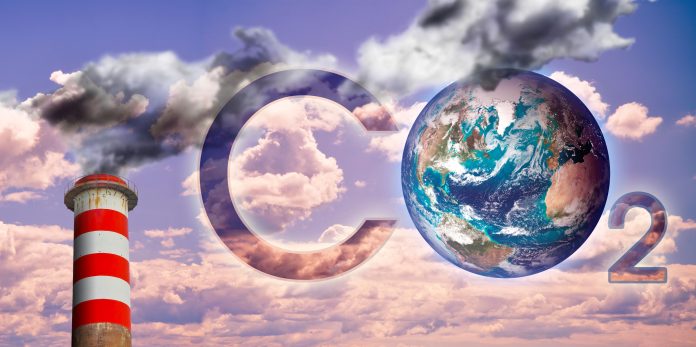Mean land temperature will exceed 2.5 °C by about 2035, if these current rates of warming continue, a study claims.
MUMBAI, Feb 6 (The CONNECT) – Global warming has already exceeded 1.5 degrees and the environmental crisis can engulf the earth earlier than the previous estimates, claims a study.
The land-air temperatures have been increasing at almost twice the rate of the and are now ∼2 °C above pre-industrial levels, the study, carried by Nature.com, says.
If these current rates of warming continue, mean land temperature will exceed 2.5 °C by about 2035, with GMSTs – global mean surface temperatures – expected to follow in early 2040, the study says.
The open access article – 300 years of sclerosponge thermometry shows global warming has exceeded 1.5 °C– is authored by Malcolm T. McCulloch, Amos Winter, Clark E. Sherman & Julie A. Trotter.
(It has to be noted here that the United Nations has already cautioned the world that “the earth is now about 1.1°C warmer than it was in the 1800s”.
“We are not on track to meet the Paris Agreement target to keep global temperature from exceeding 1.5°C above pre-industrial levels. That is considered the upper limit to avoid the worst fallout from climate change,” the UN says.)
The latest study carried in Nayure.com says that “We have shown that the late-twentieth-century land-air temperatures have been increasing at almost twice the rate of the surface oceans and are now ∼2 °C above pre-industrial levels”.
If these current rates of warming continue, mean land temperature will exceed 2.5 °C by about 2035, with GMSTs – global mean surface temperatures – expected to follow in early 2040.
Consequently, the overriding aim of the UN Paris agreement to keep the combined land and ocean global surface temperature increase to below 2 °C is now a much greater challenge, emphasizing the even more urgent need to halve emissions by 2030, the study warns.
Global warming is causing major changes to the Earth’s climate, with heatwaves of unprecedented scale occurring across southern Europe, China and large parts of North America.

The Calamitous Climate Change
- As greenhouse gas concentrations rise, so does the global surface temperature.
- As temperatures rise, more moisture evaporates, which exacerbates extreme rainfall and flooding, causing more destructive storms.
- Global warming exacerbates water shortages in already water-stressed regions and is leading to an increased risk of agricultural droughts affecting crops, and ecological droughts increasing the vulnerability of ecosystems.
- As the ocean warms, its volume increases since water expands as it gets warmer. Melting ice sheets also cause sea levels to rise, threatening coastal and island communities.
- Exacerbated by climate change, the world is losing species at a rate 1,000 times greater than at any other time in recorded human history. One million species are at risk of becoming extinct within the next few decades.
- Changes in the climate and increases in extreme weather events are among the reasons behind a global rise in hunger and poor nutrition. Fisheries, crops, and livestock may be destroyed or become less productive.
- Climate impacts are already harming health, through air pollution, disease, extreme weather events, forced displacement, pressures on mental health, and increased hunger and poor nutrition.
- Climate change increases the factors that put and keep people in poverty. Floods may sweep away urban slums, destroying homes and livelihoods. Heat can make it difficult to work in outdoor jobs. (Sources from the UN)

The Nature.com article says, furthermore, during the 2023 Northern Hemisphere summer, heatwaves occurred towards the end of a prolonged La Niña cool phase, when global mean temperatures were below the long-term warming trend. This and the switch of ENSO (El Niño/Southern Oscillation) to a warmer-than-average El Niño phase in 2023–24, means that intense heatwaves and associated extreme events may now be the new normal.
This questions whether global mean surface temperatures (GMSTs) have, or will soon exceed, the Paris Agreement of 2015 of holding GMSTs to “well below 2 °C above pre-industrial levels and pursuing efforts to limit the temperature rise to no more than 1.5 °C above pre-industrial levels”.
Wildfires and more frequent bushfires are also an additional source of atmospheric CO2, providing an enhanced feedback mechanism.
Consequently, the overriding aim of the UN Paris agreement to keep the combined land and ocean global surface temperature increase to below 2 °C is now a much greater challenge, emphasizing the even more urgent need to halve emissions by 2030.
Excerpts from the study:
Anthropogenic emissions drive global-scale warming yet the temperature increase relative to pre-industrial levels is uncertain.
Using 300 years of ocean mixed-layer temperature records preserved in sclerosponge carbonate skeletons, we demonstrate that industrial-era warming began in the mid-1860s, more than 80 years earlier than instrumental sea surface temperature records.
The Sr/Ca palaeothermometer was calibrated against ‘modern’ (post-1963) highly correlated (R2 = 0.91) instrumental records of global sea surface temperatures, with the pre-industrial defined by nearly constant (<±0.1 °C) temperatures from 1700 to the early 1860s.
Increasing ocean and land-air temperatures overlap until the late twentieth century, when the land began warming at nearly twice the rate of the surface oceans.
Hotter land temperatures, together with the earlier onset of industrial-era warming, indicate that global warming was already 1.7 ± 0.1 °C above pre-industrial levels by 2020. Our result is 0.5 °C higher than IPCC – Intergovernmental Panel on Climate Change – estimates, with 2 °C global warming projected by the late 2020s, nearly two decades earlier than expected.
We have shown that the late-twentieth-century land-air temperatures have been increasing at almost twice the rate of the and are now ∼2 °C above pre-industrial levels. If these current rates of warming continue, mean land temperature will exceed 2.5 °C by about 2035, with GMSTs – global mean surface temperatures – expected to follow in early 2040. Consequently, the overriding aim of the UN Paris agreement to keep the combined land and ocean global surface temperature increase to below 2 °C is now a much greater challenge, emphasizing the even more urgent need to halve emissions by 2030.
Global warming is causing major changes to the Earth’s climate, with heatwaves of unprecedented scale occurring across southern Europe, China and large parts of North America.
Furthermore, during the 2023 Northern Hemisphere summer, heatwaves occurred towards the end of a prolonged La Niña cool phase, when global mean temperatures were below the long-term warming trend. This and the switch of ENSO (El Niño/Southern Oscillation) to a warmer-than-average El Niño phase in 2023–24, means that intense heatwaves and associated extreme events may now be the new normal.
This questions whether global mean surface temperatures (GMSTs) have, or will soon exceed, the Paris Agreement of 2015 of holding GMSTs to “well below 2 °C above pre-industrial levels and pursuing efforts to limit the temperature rise to no more than 1.5 °C above pre-industrial levels”.
To address this question and whether even more extreme events are likely in the near future requires knowledge of the total magnitude of global warming that has occurred since the pre-industrial period.
Understanding how greenhouse forced warming has affected land-air temperatures relative to the much larger heat sink of the upper ocean remains a challenge. Here, we assume that, relative to the 1961–1990 reference period, the same fixed offset of 0.9 °C can be applied to land-air as well as the OML -ocean mixed-layer- anomalies, although there are larger uncertainties12 in land-based records from 1750 to 1860.
Despite this limitation, there is nevertheless good agreement between the land-air and OML records, especially during the historically well-documented Tambora eruption when volcanic aerosols induced global cooling.
Significantly, from mid-1860 to 1900, both land and OML temperatures increased synchronously by ∼0.3 °C. Conversely, over the same IPCC 1850–1900 pre-industrial period, Had SST – sea surface temperature – is initially up to 0.6 °C warmer followed by an anomalous cooling trend compared to the well-defined OML and land records of consistent warming from the 1860s.
Our findings now resolve the ‘warm-land cool-ocean’ conundrum posed by using the IPCC10,16 pre-industrial reference period.
Hence modern observations should continue to be referenced to the 1961–1990 mean but with an adjustment of +0.9 °C to account for the temperature increase since the onset of industrial-era warming in the mid-1860s to the 1961–1990 mean.
On this basis, the land and SST records have shown a generally coherent response to ENSO up until the 1990s, characterized by relatively warmer land temperatures during strong El Niño and cooler temperatures during La Niña events (Fig. 5a). Importantly, however, the long-term similarity in rates of land and upper ocean surface warming starts to breakdown in the late twentieth century, with land-air temperatures now increasing at nearly twice the rate of the surface oceans regardless of the ENSO phase.
Rather than the land-air record being part of an ongoing post-1900s warming trend relative to the IPCC 1850–1900 pre-industrial period, as currently assumed16, our findings show a distinct divergence from the surface ocean from around 1980–1990.
This is consistent with the already well-documented amplified warming of the high-latitude Northern Hemisphere land masses and the decline of Artic permafrost. This change also coincides with the increased frequency of both Southern Hemisphere and Northern Hemisphere heatwaves and associated extreme events, such as droughts and wild fires.
Wildfires and more frequent bushfires are also an additional source of atmospheric CO2, providing an enhanced feedback mechanism.
Although the relative importance of the regional and global processes driving the increased frequency and intensity of land-based heatwaves is still uncertain, our revised record of industrial-era warming now clearly shows that terrestrial environments have been subject to a much faster rate of warming since the 1990s, compared to those in the more stable OML of the upper surface oceans.
These findings also have important implications for near-term projections of global warming. As already described, relative to the 1961–1990 reference, OML and land temperatures (and hence GMSTs increased by ∼0.9 ± 0.1 °C since the 1700–1860 pre-industrial period. This compares with only ∼0.4 °C when HadSST4 and land temperatures are estimated relative to the IPCC 1850–1900 pre-industrial period10, a difference of 0.5 °C (Fig. 5b).
The additional 0.5 °C in global warming above IPCC estimates1 also implies that GMSTs were ∼1.7 ± 0.1 °C above 1700–1860 pre-industrial levels by 2018–2022, compared to the IPCC estimate1 of ∼1.2 ± 0.1 °C (Fig. 5b). Thus, the opportunity to limit global warming to no more than 1.5 °C by emission reductions alone has now passed and at current emission rates, the 2 °C threshold for GMSTs will be reached by the late 2020s
We have shown that the late-twentieth-century land-air temperatures have been increasing at almost twice the rate of the surface ocean and are now ∼2 °C above pre-industrial levels.
If these current rates of warming continue, mean land temperature will exceed 2.5 °C by about 2035, with GMSTs expected to follow in early 2040.
Consequently, the overriding aim of the UN Paris agreement to keep the combined land and ocean global surface temperature increase to below 2 °C is now a much greater challenge, emphasizing the even more urgent need to halve emissions by 2030.




